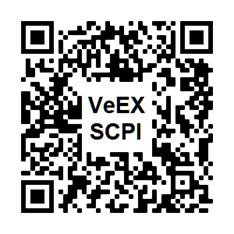What are SCPI Commands?
The Standard Commands for Programmable Instruments (SCPI) is a scripting language designed for controlling instruments and automate tasks.

The Standard Commands for Programmable Instruments (SCPI) is a scripting language structure designed specifically for controlling instruments, to automate tasks. It defines how a controller device (e.g., PC), running a list of commands and decision-making algorithms (scripts), communicates with the instrument(s) to automate a process.
SCPI command syntax follows a structure or tree, similar to file systems, to show a logical construction based on the actual subsystems and being somewhat self-documented. VeEX test sets use SUBSYSTEM style command constructions, in which each of the level (hierarchical) keywords are separated by colons ":", with the arguments separated by a space, and commas "," for additional values. Commands end with a semicolon ";". Each command subsystem is a set of building blocks that correspond to a functional block inside the instrument, feature or function being executed.
For example:
:P1:TX:SDH:STM16:CHAN 1;
Which (almost in reverse order) means: Use channel 1 for the STM16 payload on the SDH function's transmitter side in port 1.
The following image depicts the relationship between the user interface structure of one instrument (which already follows the construction of the test signal structure) and the related commands.

Refer to How to Use Command Line Interface (CLI & SCPI for Scripting to get more details.
For certain test applications, users can also initiate a telnet session, allocate the target test resources, launch the test application and enter the following SCPI command :DEBUG:INFO?; or :DEBUG:INFO ?; to get a raw list of all current commands, argument types, ranges, etc., for further reference. This is only available on a limited number of test applications.
Application-Specific SCPI Command Sample References
Although the handheld/portable test sets are not meant to be used in permanent test automation applications, they do support SCPI commands meant for internal automating regression testing and their own final production tests. However, some of our customers can use the same commands to create their own scripts to automate their tests.
To download a copy of the VeEX SCPI Remote & Command Reference Tool install package for Windows PC (30-day trial included) and SCPI Commands Getting Started Guide samples for applications such as Ethernet, OTN/SDH/SONET/PDH/DSn, etc., scan (or click on) the QR code below. In the event that the downloaded ZIP file is flagged as an "Uncommon Download" or "can't be downloaded securely", click on the warning message, open the options, and select Keep and Keep Anyway. However, we take security very seriously, so we recommend not to download these files from sources different than the www.veexinc.com domain and to follow your organization's IT security policies. Please Contact Us if you encounter any issues.
 www.veexinc.com/SecureFile/VeEX_SCPI-Remote_Package.zip
www.veexinc.com/SecureFile/VeEX_SCPI-Remote_Package.zip
The SCPI Commands Sample Guides are offered as visual references with examples of some common/typical commands structures, syntax, but not meant to provide a complete list of all available commands. For the actual command reference, VeEX offers the self-guided SCPI Remote & Command Reference Tool as the main documentation for script developers.
